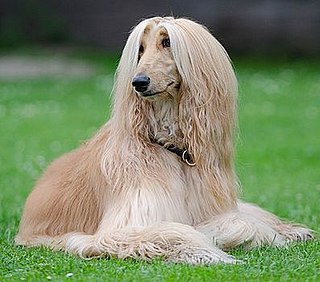
The Afghan Hound is a hound distinguished by its thick, fine, silky coat, and a tail with a ring curl at the end. The breed originates in the cold mountains of Afghanistan. Its local name is Sag-e Tāzī or Tāžī Spay. Other names for this breed are Tāzī, Balkh Hound, Baluchi Hound, and Barakzai Hound.

The EnglishGreyhound, or simply the Greyhound, is a breed of dog, a sighthound which has been bred for coursing, greyhound racing and hunting. Since the rise in large-scale adoption of retired racing Greyhounds, the breed has seen a resurgence in popularity as a family pet.
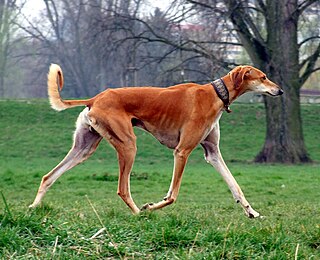
The Saluki is a standardised breed developed from sighthounds – dogs that hunt primarily by sight rather than strong scent – that was once used by nomadic tribes to run down game animals. The dog was originally bred in the Arabian Peninsula. The modern breed is typically deep-chested and long-legged, and similar dogs appear in medieval and ancient art. The breed is most closely related to the Afghan hound, a basal breed that predates the emergence of modern breeds in the 19th century, and the Saluki has been purebred both in the Middle East, including by royalty, since at least that era, and in the West since the 1840s, though as a free-breeding landrace, similar dogs are common as feral animals in the Middle East. A related standardised breed is the north African Sloughi.
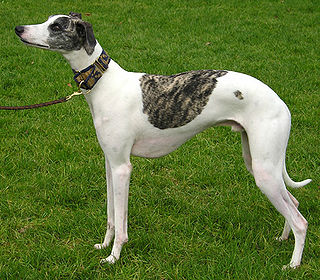
Sighthounds, also called gazehounds, are a type of dog, hounds that hunt primarily by sight and speed rather than by scent and endurance as scent hounds do.

The Sloughi, or Arabian Greyhound, is an ancient breed of domesticated dog, specifically a member of the sighthound family. It originates from North Africa and is found in Algeria, Tunisia, Morocco and Libya.

The whippet is a British breed of medium-sized dog, of the sighthound type, related to the larger greyhound and the smaller Italian greyhound. Apart from the differences in height, the whippet closely resembles these two breeds; it has sometimes been described as "the poor man's greyhound". It is kept as a companion dog, for competitive showing, for amateur racing as well as lure coursing. It has the highest running-speed of any breed in its weight and size range, and may have the fastest idle-to-running acceleration of any dog.

A hound is a type of hunting dog used by hunters to track or chase prey.

The Boxer is a medium to large, short-haired dog breed of mastiff-type, developed in Germany. The coat is smooth and tight-fitting; colors are fawn, brindled, or white, with or without white markings. Boxers are brachycephalic, have a square muzzle, mandibular prognathism, very strong jaws, and a powerful bite ideal for hanging on to large prey. The Boxer was bred from the Old English Bulldog and the now extinct Bullenbeisser, which became extinct by crossbreeding rather than by a decadence of the breed. The Boxer is a member of both The Kennel Club and American Kennel Club (AKC) Working Group.
Lure coursing is a sport for dogs that involves chasing a mechanically operated lure. Competition is typically limited to dogs of purebred sighthound breeds. The AKC has a pass/fail trial for all breeds called the Coursing Ability Test (CAT) and a timed 100 yard dash called Fast CAT where the dog's speed is converted to points.

The Fédération Cynologique Internationale is the largest international federation of national kennel clubs and purebred registries. The FCI is based in Thuin, Belgium and has 98 members and contract partners.

The Poodle, called the Pudel in German and the Caniche in French, is a breed of water dog. The breed is divided into four varieties based on size, the Standard Poodle, Medium Poodle, Miniature Poodle and Toy Poodle, although the Medium Poodle is not universally recognised. They have a distinctive thick, curly coat that comes in many colors and patterns, with only solid colors recognized by breed registries. Poodles are active and intelligent, and are particularly able to learn from humans. Poodles tend to live 10–18 years, with smaller varieties tending to live longer than larger ones.

A lurcher is a crossbred dog resulting from mating a greyhound or other sighthound with a dog of another type such as a herding dog or a terrier. The lurcher was for hundreds of years strongly associated with poaching; in modern times, it is kept as a hunting dog or companion dog.

The Carolina dog, also known as a yellow dog, yaller dog, American dingo, or Dixie dingo, is a breed of medium-sized dog occasionally found feral in the Southeastern United States, especially in isolated stretches of longleaf pines and cypress swamps. Efforts to establish them as a standardized breed have gained the Carolina Dog breed recognition in two smaller kennel clubs and full acceptance into the breed-establishment program of one major kennel club.

The Dutch Shepherd is a herding dog of Dutch origin. They were used by shepherds and farmers who needed a versatile dog, with few demands, and a dog that was able to adapt to a harsh and meager existence.
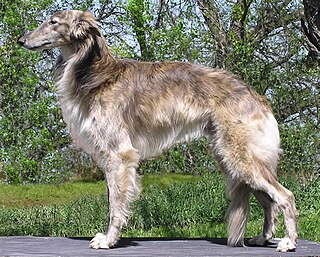
The Silken Windhound is an American breed of sighthound. Like most sighthounds, Silkens are noted coursers.

Danish–Swedish farmdog is a breed of dog that has its origin in Denmark and southern Sweden, but has become popular all over Scandinavia. It is a native breed which has historically lived on farms in the eastern part of Denmark and southernmost part of Sweden, serving as a guard dog, rat catcher and hunting dog. The breed's soft and gentle temperament also makes them excellent companion dogs. There are some indications that the breed originates from the pinscher breeds and the British white hunting terriers.

The Taigan, and also known as Kyrgyz Taighany, Mongolian Taiga dog is a breed of sighthound from Kyrgyzstan. The Taigan is found in the alpine Tian Shan region of Kyrgyzstan on the border with China, it is closely related to the Tazy and the Saluki.
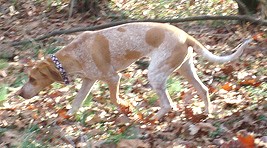
The American English Coonhound, also referred to as the English Coonhound or the Redtick Coonhound, is a breed of coonhound that originated in and is typically bred in the Southern United States. It is descended from hunting hounds, especially foxhounds, brought to America by settlers during the 17th and 18th centuries. The breed's first recognition came from the United Kennel Club in 1905 as the English Fox and Coonhound. Further recognition has been granted in recent years by the American Kennel Club, first in the Foundation Stock Service and in 2011 as a fully recognized member of the hound group.

The Russian Toy is a very small breed of dog originally bred in Russia from the English Toy Terrier. There are two types of coats in the breed: smooth coat and long coat. The smooth-coated variety was previously known as the Russian Toy Terrier and long-coated as the Moscow Long-Haired Toy Terrier. Both were brought together under the same Russian Toy Terrier name in 1988 and the "Terrier" was dropped from the name when the breed was added in 2006 to the official list of breeds registered with the Fédération Cynologique Internationale and has been registered in the Foundation Stock Service of the American Kennel Club since 2008, allowed to compete in AKC companion events since 2010. The first official breed standard of the two varieties was written in 1966 in Russia.

Tesem was the ancient Egyptian name for "hunting dog". In popular literature it denotes the prick-eared, leggy dog with a curled tail from the early Egyptian age, but it was also used with reference to the lop-eared "Saluki/Sloughi" type. It was one of several types of dogs in Ancient Egypt; particularly the latter Saluki/Sloughi type of Tesem, having the appearance most similar to that of a true sighthound.























